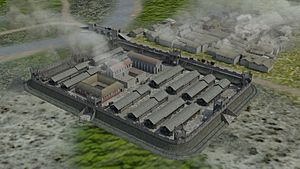Ilkley Roman Fort facts for kids
Quick facts for kids Ilkley Roman Fort |
|
|---|---|

Remains of the outer walls at the Roman Fort, looking towards Ilkley Manor House
|
|
| Known also as | Olicana(?) |
| Founded | c. 80 AD |
| Abandoned | 4th - 5th century AD |
| Place in the Roman world | |
| Province | Britannia |
| Structure | |
| — Stone structure — | |
| — Wood and earth structure — | |
| Built | c. 80 AD |
| Events | Abandoned c. 120 AD |
| Location | |
| Coordinates | 53°55′37″N 1°49′30″W / 53.927°N 1.825°W |
| Town | Ilkley |
| County | West Yorkshire |
| Country | England |
| Reference | |
| UK-OSNG reference | SE115478 |
The Ilkley Roman Fort was an important Roman army base. It was built on the south bank of the River Wharfe. Today, the town of Ilkley in West Yorkshire, England stands right where the fort used to be. This fort was a key part of the Roman presence in ancient Britannia.
What Was Its Name?
Historians are not completely sure about the Roman name for the fort at Ilkley. Many people believe it was called Olicana. This name comes from a very old map made by Ptolemy around 150 AD.
However, some experts think Olicana might have been the name for a different fort. They suggest the Ilkley fort could have been called Verbeia. This name comes from the Roman name for the River Wharfe, which is nearby. An ancient stone altar found at the site, dedicated to the goddess Verbeia, supports this idea.
History of the Fort
The first Roman fort at Ilkley was built around 80 AD. It was made mostly from wood and earth. This first fort was used for about 40 years, then it was left empty around 120 AD.
Later, around 161 AD, a second fort was built. This one lasted for about 30 years. It was then burned down, possibly during a rebellion by local tribes in northern Britain. But the Romans quickly rebuilt it.
The third fort was made of strong stone. This stone fort stayed in use until the very end of the Roman period in Britain. The Romans finally left the fort in the late 4th or early 5th century.
After the Roman soldiers left, a civilian settlement grew up around the fort. This settlement, called a vicus, likely became the start of the village that is now Ilkley. Later, Anglo-Saxons settled here. Evidence like carved crosses shows that a church was present in the 8th and 9th centuries.
Ilkley Fort Today
You can still see parts of the Roman fort today in Ilkley. A section of the old fort wall is visible near the town's old Manor House Art Gallery & Museum. There are also signs around the area showing where the fort's walls once stood.
The fort's original area stretches under the Manor House and the nearby All Saints Parish Church. Inside the church, you can see a collection of Roman altars and Anglo-Saxon crosses. The Roman altars have carvings that tell us they were made during the time of Roman emperors like Antoninus Pius (who ruled from 138 to 161 AD) and Septimius Severus and his son Caracalla (who ruled from 211 to 217 AD).
See also
 In Spanish: Olicana para niños
In Spanish: Olicana para niños




